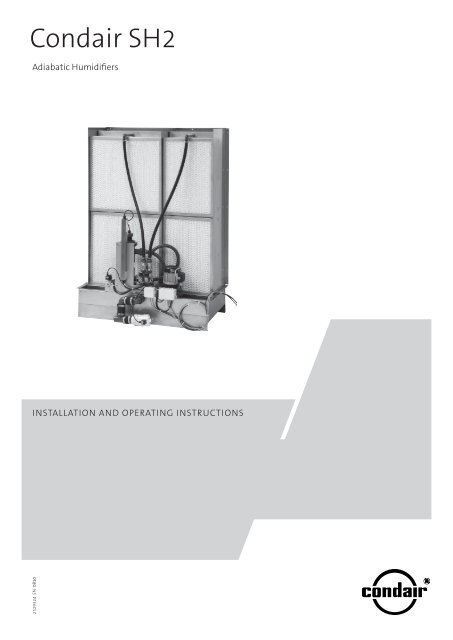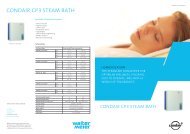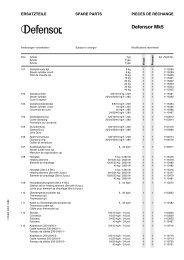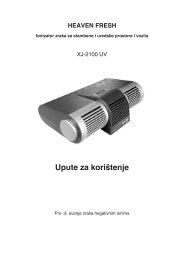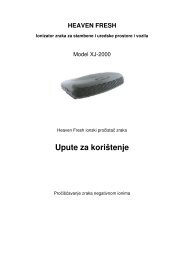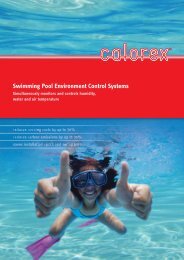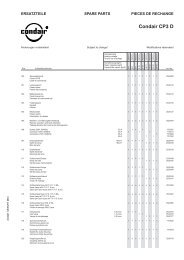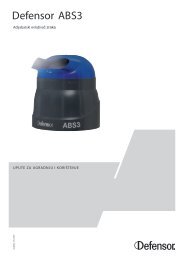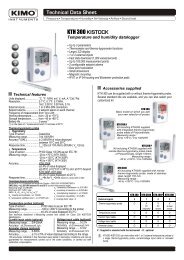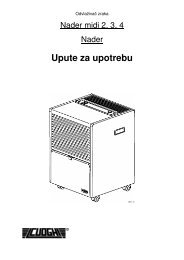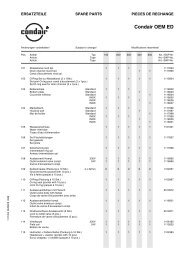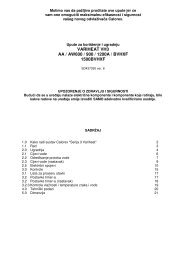condair sH2
condair sH2
condair sH2
Create successful ePaper yourself
Turn your PDF publications into a flip-book with our unique Google optimized e-Paper software.
Condair SH2<br />
Adiabatic Humidifiers<br />
Installation and operating instructions<br />
2529324 EN 0810
Contents<br />
1 Introduction 4<br />
1.1 To the very beginning 4<br />
1.2 Notes on the installation and operating instructions 4<br />
2 For your safety 6<br />
5 Operation 48<br />
5.1 Putting into operation 48<br />
5.2 Adjust the volume controlling valves 48<br />
5.3 Notes on operation 49<br />
5.4 Taking out of operation 49<br />
3 Product overview 8<br />
3.1 Model overview 8<br />
3.2 Product designation 8<br />
3.3 Model “flow” 10<br />
3.3.1 Construction model “flow” 10<br />
3.3.2 System overview model “flow” 11<br />
3.4 Model “flow C” 12<br />
3.4.1 Construction model “flow C” 12<br />
3.4.2 System overview model “flow C” 13<br />
3.5 Model “flow SC” 14<br />
3.5.1 Construction Model “flow SC” 14<br />
3.5.2 System overview model “flow SC” 15<br />
3.6 Model “REflow” 16<br />
3.6.1 Construction model “REflow” 16<br />
3.6.2 System overview model “REflow” 17<br />
3.7 Model “REflow C” 18<br />
3.7.1 Construction model “REflow C” 18<br />
3.7.2 System overview model “REflow C” 19<br />
3.8 Model “REflow SC” 20<br />
3.8.1 Construction model “REflow SC” 20<br />
3.8.2 System overview model “REflow SC” 21<br />
3.9 Standard delivery 22<br />
3.10 Storing/Transport/Packaging 22<br />
6 Maintenance 50<br />
6.1 Important notes on maintenance 50<br />
6.2 Maintenance intervals 51<br />
6.3 Maintenance work 51<br />
6.4 Dismantling and installation works 53<br />
6.4.1 Dismantle and install the mist eliminator<br />
and humidification boxes 53<br />
6.4.2 Dismantle and install the UV lamp (option) 54<br />
6.5 Resetting the maintenance indication 54<br />
7 Malfunctions 55<br />
7.1 Malfunction list 55<br />
7.2 Notes on fault elimination 56<br />
8 Taking out of service/Disposal 57<br />
8.1 Taking out of service 57<br />
8.2 Disposal/Recycling 57<br />
9 Product specifications 58<br />
9.1 Technical data 58<br />
9.2 Unit dimensions 59<br />
4 Installation 23<br />
4.1 Important notes on the mounting and<br />
installation work 23<br />
4.2 Unit mounting 23<br />
4.2.1 Note on locating the unit 23<br />
4.2.2 Mounting process 25<br />
4.3 Water installation 38<br />
4.3.1 Overviews water installation 38<br />
4.3.2 Notes on water installation 41<br />
4.4 Electric installation 42<br />
4.4.1 Leading the electric cables out of the duct 42<br />
4.4.2 Mounting the control unit SH2 43<br />
4.4.3 Wiring diagram Condair SH2 flow C 44<br />
4.4.4 Wiring diagram Condair SH2 flow SC 45<br />
4.4.5 Wiring diagram Condair SH2 REflow C 46<br />
4.4.6 Wiring diagram Condair SH2 REflow SC 47
1 Introduction<br />
1.1 To the very beginning<br />
We thank you for having purchased the Adiabatic Air Humidifier Condair SH2.<br />
The adiabatic air humidifier Condair SH2 incorporates the latest technical advances and meets all<br />
recognized safety standards. Nevertheless, improper use of the adiabatic air humidifier Condair SH2<br />
may result in danger to the user or third parties and/or impairment of material assets.<br />
To ensure a safe, proper, and economical operation of the adiabatic air humidifier Condair SH2, please<br />
observe and comply with all information and safety instructions contained in the present installation<br />
and operating instructions as well as in the separate documentations of the components installed<br />
in the humidification system.<br />
If you have questions, which are not or insufficiently answered in this documentation, please contact<br />
your Condair supplier. They will be glad to assist you.<br />
1.2 Notes on the installation and operating instructions<br />
Limitation<br />
The subject of these installation and operating instructions is the adiabatic air humidifier<br />
Condair SH2. The various accessories are only described insofar as this is necessary for proper<br />
operation of the equipment. Further information on accessories can be obtained in the respective<br />
instructions.<br />
These installation and operating instructions are restricted to the installation, commissioning, operation,<br />
servicing, and trouble-shooting of the adiabatic air humidifier Condair SH2 and is meant<br />
for well trained personnel being sufficiently qualified for their respective work.<br />
The installation and operating instructions are supplemented by various separate items of documentation<br />
(spare parts list, manuals for accessories, etc.). Where necessary, appropriate cross-references<br />
are made to these publications in the installation and operating instructions.
Symbols used in this manual<br />
CAUTION!<br />
The catchword “CAUTION” designates notes in this installation and operating instructions<br />
that, if neglected, may cause damage and/or malfunction of the unit<br />
or other material assets.<br />
WARNING!<br />
The catchword “WARNING” used in conjunction with the general caution symbol<br />
designates safety and danger notes in this installation and operating instructions<br />
that, if neglected, may cause to injury to persons.<br />
DANGER!<br />
The catchword “DANGER” used in conjunction with the general caution symbol<br />
designates safety and danger notes in this installation and operating instructions<br />
that, if neglected, may lead to severe injury or even death of persons.<br />
Safekeeping<br />
Please safeguard these installation and operating instructions in a safe place, where they can be<br />
immediately accessed. If the equipment changes hands, the documentation must be passed on to<br />
the new operator.<br />
If the documentation gets mislaid, please contact your Condair supplier.<br />
Language versions<br />
These installation and operating instructions are available in various languages. Please contact your<br />
Condair supplier for information.<br />
Copyright protection<br />
The present installation and operating instructions is protected under the Copyright Act. Passing-on<br />
and reproduction of the manual (or part thereof) as well as exploitation and communication of the<br />
contents are prohibited without written permission by the manufacturer. Violation of copyright terms<br />
is subject to legal prosecution and arises liability for indemnification.<br />
The manufacturer reserves the right to fully exploit commercial patent rights.
2 For your safety<br />
General<br />
Every person working with the Condair SH2 must have read and understood the installation and<br />
operating instructions before carrying out any work.<br />
Knowing and understanding the contents of the installation and operating instructions is a basic<br />
requirement for protecting the personnel against any kind of danger, to prevent faulty operation, and<br />
to operate the unit safely and correctly.<br />
All ideograms, signs and markings applied to the unit must be observed and kept in readable<br />
state.<br />
Qualification of personnel<br />
All work (installation, operating, servicing , etc.) described in these installation and operating instructions<br />
may only be carried out by specialist who are well trained and adequately qualified and<br />
are authorized by the customer.<br />
For safety and warranty reasons any action beyond the scope of this manual must be carried out<br />
only by qualified personnel authorised by the manufacturer.<br />
It is assumed that all persons working with the Condair SH2 are familiar and comply with the appropriate<br />
regulations on work safety and the prevention of accidents.<br />
Intended use<br />
The adiabatic air humidifier/cooler Condair SH2 are intended exclusively for air humidification/air<br />
cooling in air ducts or monoblocs within the specified operating conditions (see chapter 9 “Product<br />
specifications”. Any other type of application, without the written consent of your Condair supplier,<br />
is considered as not conforming with the intended purpose and may lead to the Condair SH2<br />
becoming dangerous.<br />
Operation of the equipment in the intended manner requires that all the information in these<br />
instructions are observed (in particular the safety instructions).
Danger that may arise from the unit<br />
– Some components of the Condair SH2 are mains powered.<br />
DANGER!<br />
One may get in touch with live parts when the control unit or the distribution<br />
boxes are open. Touching live parts may cause severe injury or danger<br />
to life.<br />
Prevention:<br />
Before carrying out any work set the Condair SH2 out of operation as described<br />
in chapter 5.4 (switch off the unit, disconnect it from the mains and<br />
stop the water supply) and secure the unit against inadvertent power-up.<br />
– The UV lamp used in the water treatment unit (option) emits harmful UV-C rays.<br />
WARNING!<br />
If the UV lamp is operated outside the housing, the emitted UV-C rays may<br />
damage the eyes and the skin lasting.<br />
Prevention:<br />
Never operate the UV lamp outside the housing.<br />
– Badly maintained humidifiers can endanger the health.<br />
WARNING!<br />
Prevention:<br />
If the unit is insufficient maintained ill-making germs may grow in the water<br />
tub and the humidification boxes (and the mist eliminator) of the Condair<br />
SH2 and may can affect the air passing through the humidifier.<br />
The Condair SH2 must be cleaned in the prescribed intervals according to<br />
the information given in chapter 6 “Maintenance". The cleaning works must<br />
be carried out correctly and the humidification boxes and the mist eliminator<br />
boxes must be replaced after their prescribed lifetime has elapsed.<br />
Behaviour in case of danger<br />
If it is suspected that safe operation is no longer possible, then the Condair SH2 should immediately<br />
be shut down and secured against accidental power-up according to chapter 5.4. This can<br />
be the case under the following circumstances:<br />
– if the Condair SH2 is damaged<br />
– if the Condair SH2 is no longer operating correctly<br />
– if connections and/or piping are not sealed<br />
– if electrical cables are defective<br />
All persons working with the Condair SH2 must report any alterations to the unit that may affect<br />
safety to the owner without delay.<br />
Prohibited modifications to the unit<br />
No modifications must be undertaken on the Condair SH2 without the express written consent<br />
of the manufacturer.<br />
For the replacement of defective components use exclusively original accessories and spare parts<br />
available from your Condair supplier.
3 Product overview<br />
3.1 Model overview<br />
The Condair SH2 is available in the two base versions “flow” with direct water system and “REflow”<br />
with circulating water system. The following base models are available:<br />
– Condair SH2 flow<br />
– Condair SH2 flow C (with control unit RC and On/Off control)<br />
– Condair SH2 flow SC (with control unit SH2 and step control)<br />
– Condair SH2 REflow<br />
– Condair SH2 REflow C (with control unit SH2 and On/Off control)<br />
– Condair SH2 REflow SC (with control unit SH2 and step control)<br />
All base models can be extended in their functions by different options. In addition there are different<br />
accessories available for all models.<br />
3.2 Product designation<br />
The product designation and the most important unit data are found on the rating plate:<br />
Type designation Serial number Month/Year<br />
Supply voltage<br />
Humidification capacity<br />
Admissible water supply pressure<br />
Certificates<br />
Type key<br />
Walter Meier (Climate International) Ltd. 8808 Pfäffikon, Switzerland<br />
SH2 REflow SC<br />
XXXXXXX 03.07<br />
230V 1~ / 50Hz<br />
393 VA<br />
Befeuchtungsleistung = 150.0 kg/h REflow SC 300 1800 2000 1 150<br />
Fliessdruck 2...10 bar max. 45°C<br />
Made in Switzerland<br />
Power consumption
Type key<br />
Example:<br />
Condair SH2 REflow SC 300 1800 2000 0 150<br />
Model:<br />
flow<br />
flow C<br />
flow SC<br />
REflow<br />
REflow C<br />
REflow SC<br />
Depth of humidification box:<br />
200 mm<br />
300 mm<br />
Order code width W<br />
Order code height H<br />
Mist eliminator:<br />
No mist eliminator: 0<br />
Mist eliminator 100 mm: 1<br />
Mist eliminator 200 mm: 2<br />
Humidification capacity in kg/h according layout
10<br />
3.3 Model “flow”<br />
3.3.1 Construction model “flow”<br />
6<br />
7<br />
8<br />
5<br />
2<br />
1<br />
4<br />
3<br />
1 Water connection on unit R 3/4" (outside thread)<br />
2 Volume controlling valves (adjustable manually)<br />
3 Water tub<br />
4 Open drain (ø 40/34 mm)<br />
5 Water hoses<br />
6 Trickling hoods with distribution pipes<br />
7 Humidification boxes<br />
8 Mist eliminator (for air speed above humidification boxes >3.8 m/s)
11<br />
3.3.2 System overview model “flow”<br />
Volume controlling valves<br />
(adjustable manually)<br />
Humidification boxes<br />
Water tub<br />
Open drain<br />
Water connection unit (accessory)<br />
Water filter<br />
Siphon (building side)<br />
Pressure reducing valve<br />
Drain funnel (building side)<br />
Shut-off valve<br />
Control: via humidistat that actuates the supply valve depending on the humidification requests<br />
Water supply<br />
2...10 bar<br />
Functional description<br />
In case of a humidification/cooling request the supply valve (accessory) opens and the water flows<br />
via the pressure reducing valve (accessory), the water filter (accessory) and the manually adjustable<br />
volume controlling valves to the distribution pipes above the humidification boxes.<br />
The distribution pipes evenly supply the water to the entire surface of the humidification boxes where<br />
it flows down and humidifies the air flowing through the humidification boxes. The excess water not<br />
used for humidification flows to the water tub and then directly to the drain.
12<br />
3.4 Model “flow C”<br />
3.4.1 Construction model “flow C”<br />
9<br />
6<br />
7<br />
8<br />
5<br />
1<br />
2<br />
4<br />
3<br />
1 Water connection on unit R 3/4" (outside thread)<br />
2 Volume controlling valves (adjustable manually)<br />
3 Water tub<br />
4 Open drain (ø 40/34 mm)<br />
5 Water hoses<br />
6 Trickling hoods with distribution pipes<br />
7 Humidification boxes<br />
8 Mist eliminator (for air speed above humidification boxes >3.8 m/s)<br />
9 Control unit RC
13<br />
3.4.2 System overview model “flow C”<br />
Volume controlling valves<br />
(adjustable manually)<br />
Humidification boxes<br />
Supply valve<br />
Water tub<br />
Water connection unit (accessory)<br />
Water filter<br />
Control unit RC<br />
Output:<br />
Supply valve<br />
Open drain<br />
Siphon (building side)<br />
Pressure reducing valve<br />
L1 N S S<br />
Drain funnel (building side)<br />
Shut-off valve<br />
Humidistat 230V/2A<br />
%rH<br />
Water supply<br />
2...10 bar<br />
Input:<br />
Potential free contact 230 V<br />
PE L1 N<br />
Functional description<br />
The “flow C” model provides On/Off control by means of the RC control unit and an external On/Off<br />
humidistat. In case of a humidification/cooling request the supply valve opens and the water flows<br />
via the pressure reducing valve (accessory), the water filter (accessory) and the manually adjustable<br />
volume controlling valves to the distribution pipes above the humidification boxes.<br />
The distribution pipes evenly supply the water to the entire surface of the humidification boxes where<br />
it flows down and humidifies the air flowing through the humidification boxes. The excess water not<br />
used for humidification flows to the water tub and then directly to the drain.
14<br />
3.5 Model “flow SC”<br />
3.5.1 Construction Model “flow SC”<br />
7<br />
11<br />
8<br />
9<br />
10<br />
6<br />
2<br />
3<br />
1<br />
5<br />
4<br />
1 Water connection on unit R 3/4" (outside thread)<br />
2 Volume controlling valves (adjustable manually)<br />
3 Step valves (1 to 3)<br />
4 Water tub<br />
5 Open drain (ø 40/34 mm)<br />
6 Water hoses<br />
7 Trickling hoods with distribution pipes<br />
8 Humidification boxes<br />
9 Mist eliminator (for air speed above humidification boxes >3.8 m/s)<br />
10 UV water treatment (option)<br />
11 Control unit SH2
15<br />
3.5.2 System overview model “flow SC”<br />
Humidification boxes<br />
UV water treatment<br />
(option)<br />
Minimum<br />
pressure switch<br />
Volume controlling valves<br />
(adjustable manually)<br />
Rinsing valve<br />
Step valves 1..3<br />
Water tub<br />
Water connection unit<br />
(standard delivery **)<br />
** installation mandatory<br />
Open drain<br />
Water filter<br />
Pressure reducing valve<br />
Inputs<br />
Outputs<br />
Minimum pressure<br />
Siphon (building side)<br />
Control unit SH2<br />
Drain funnel (building side)<br />
Shut-off valve<br />
Display<br />
Step valves 1...3<br />
Water supply<br />
2...10 bar<br />
Error<br />
Humidification<br />
UV water treatment<br />
Remote indication (On, Error, Maintenance and Humidification)<br />
Control/sensor signal analog<br />
0...5 VDC, 1...5 VDC, 0...10 VDC<br />
2...10 VDC, 0..16 VDC, 3.2...16 VDC,<br />
0..20 mA, 4..20 mA<br />
Functional description<br />
The “flow SC” model provides multistep control by means of the SH2 control unit and the step<br />
valves (1, 2 or 3 step valves depending on the humidifier capacity). The SH2 control unit (for wall<br />
mounting) processes analog sensor/control signals and uses them to control the step valves. This<br />
allows multistep control (1 to 3 steps depending on the humidifier capacity) which improves control<br />
accuracy compared to the “flow” model.<br />
In case of a humidification/cooling request one, two or all three step valves open (depending on the<br />
request). The water flows via the manually adjustable volume controlling valves to the distribution<br />
pipes above the humidification boxes.<br />
The distribution pipes evenly supply the water to the entire surface of the humidification boxes where<br />
it flows down and humidifies the air flowing through the humidification boxes. The excess water not<br />
used for humidification flows to the water tub and then directly to the drain.<br />
If the “flow SC” model is equipped with the optional UV water treatment (installed in the water<br />
supply) the water is continuously degerminated during the humidification process.
16<br />
3.6 Model “REflow”<br />
3.6.1 Construction model “REflow”<br />
11<br />
12<br />
13<br />
10<br />
1<br />
2<br />
4<br />
5<br />
9<br />
3<br />
7<br />
6<br />
8<br />
1 Water connection on unit R 3/4" (outside thread)<br />
2 Level-controlled supply valve<br />
3 Circulation pump<br />
4 Volume controlling valves (adjustable manually)<br />
5 Overflow<br />
6 Drain (ø 40/34 mm)<br />
7 Shut-off valve<br />
8 Water tub<br />
9 Drain line<br />
10 Water hoses<br />
11 Trickling hoods with distribution pipes<br />
12 Humidification boxes<br />
13 Mist eliminator (for air speed above humidification boxes >3.8 m/s)<br />
CAUTION!<br />
The circulation pump must be protected against dry operation by taking appropriate<br />
measures (by the customer).
17<br />
3.6.2 System overview model “REflow”<br />
Humidification boxes<br />
Volume controlling valves<br />
(adjustable manually)<br />
Level-controlled<br />
supply valve<br />
Circulation pump<br />
Water level<br />
Overflow<br />
Water tub<br />
Water connection unit (accessory)<br />
Shut-off valve<br />
Water filter<br />
Pressure reducing valve<br />
Shut-off valve<br />
Control:<br />
Via humidistat switching the circulation pump on or off depending on humidification<br />
request<br />
Draining:<br />
Draining is done continuously via the volume controlling valve (to the very right).<br />
Siphon (building side)<br />
Drain funnel (building side)<br />
Water supply<br />
2...10 bar<br />
Functional description<br />
The water tub is filled up to a preset upper level via the level-controlled supply valve. When the water<br />
level in the tub drops below a certain limit, the level-controlled supply valve opens until the upper<br />
limit is reached again.<br />
In case of a humidification/cooling request the circulation pump starts and supplies the water via<br />
the manually adjustable volume controlling valves to the distribution pipes above the humidification<br />
boxes.<br />
The distribution pipes evenly supply the water to the entire surface of the humidification boxes where<br />
it flows down and humidifies the air flowing through the humidification boxes. The excess water not<br />
used for humidification flows to the water tub and is fed back to the circulation pump.<br />
To prevent accumulation of mineral residues in the water tub, a limited amount of water is continuously<br />
drained via a manually adjustable volume controlling valve and replaced with fresh water.
18<br />
3.7 Model “REflow C”<br />
3.7.1 Construction model “REflow C”<br />
10<br />
13<br />
11<br />
12<br />
9<br />
2<br />
1<br />
7<br />
4<br />
3<br />
6<br />
8<br />
5<br />
1 Water connection on unit R 3/4" (outside thread)<br />
2 Level-controlled supply valve<br />
3 Circulation pump<br />
4 Overflow<br />
5 Drain (ø 40/34 mm)<br />
6 Drain valve<br />
Volume controlling valves (adjustable manually)<br />
8 Water tub<br />
9 Water hoses<br />
10 Trickling hoods with distribution pipes<br />
11 Humidification boxes<br />
12 Mist eliminator (for air speed above humidification boxes >3.8 m/s)<br />
13 Control unit SH2
19<br />
3.7.2 System overview model “REflow C”<br />
Humidification boxes<br />
Level-controlled<br />
supply valve<br />
Level switch<br />
Conductivity monitoring<br />
(option)<br />
Volume controlling valves<br />
(adjustable manually)<br />
Circulation pump<br />
Overflow<br />
Water tub<br />
Operating level = pump immediately on / delayed off<br />
Water connection unit (accessory)<br />
Water filter<br />
Pressure reducing valve<br />
Inputs<br />
Outputs<br />
Conductivity (option)<br />
Operating level<br />
Drain valve<br />
Siphon (building side)<br />
Water supply<br />
2...10 bar<br />
Stop valve<br />
Control unit SH2<br />
Display<br />
Error<br />
Humidification<br />
Drain funnel (building side)<br />
Supply valve<br />
Drain valve<br />
Circulation pump<br />
Signal On/Off humidistat<br />
Remote indication (On, Error, Maintenance and Humidification)<br />
Functional description<br />
The water tub is filled up to a preset upper level via the level-controlled supply valve. When the water<br />
level in the tub drops below a certain limit, the level-controlled supply valve opens until the upper<br />
limit is reached again.<br />
The “REflow C” model provides On/Off control by means of the SH2 control unit and an external<br />
On/Off humidistat. In case of a humidification/cooling request one, two or all three step valves open<br />
(depending on the request). The water flows via the manually adjustable volume controlling valves<br />
to the distribution pipes above the humidification boxes.<br />
The distribution pipes evenly supply the water to the entire surface of the humidification boxes where<br />
it flows down and humidifies the air flowing through the humidification boxes. The excess water not<br />
used for humidification flows to the water tub.<br />
To prevent accumulation of mineral residues and the formation of germs in the water tub, the tub<br />
is completely drained periodically (interval or time controlled). Additionally further hygiene functions<br />
can be activated: Operation-dependent draining of the water tub (conductivity or fill cycle controlled)<br />
as well as cleaning and drying of the humidification boxes.
20<br />
3.8 Model “REflow SC”<br />
3.8.1 Construction model “REflow SC”<br />
11<br />
15<br />
12<br />
13<br />
14<br />
10<br />
2<br />
1<br />
8<br />
7<br />
3<br />
4<br />
6<br />
5<br />
9<br />
1 Water connection on unit R 3/4" (outside thread)<br />
2 Level-controlled supply valve<br />
3 Circulation pump<br />
4 Overflow<br />
5 Drain (ø 40/34 mm)<br />
6 Drain valve<br />
Step valves (1 to 3)<br />
8 Volume controlling valves (adjustable manually)<br />
9 Water tub<br />
10 Water hoses<br />
11 Trickling hoods with distribution pipes<br />
12 Humidification boxes<br />
13 Mist eliminator (for air speed above humidification boxes >3.8 m/s)<br />
14 UV water treatment (option)<br />
15 Control unit SH2
21<br />
3.8.2 System overview model “REflow SC”<br />
Level-controlled<br />
supply valve<br />
Humidification boxes<br />
Level switch<br />
UV water treatment<br />
(option)<br />
Conductivity monitoring<br />
(option)<br />
Circulation pump<br />
Volume controlling valves<br />
(adjustable manually)<br />
Step valves 1..3<br />
Overflow<br />
Water tub<br />
Operating level = pump immediately on / delayed off<br />
Water connection unit (accessory)<br />
Drain valve<br />
Water filter<br />
Conductivity (option)<br />
Operating level<br />
Pressure reducing valve<br />
Inputs<br />
Outputs<br />
Siphon (building side)<br />
Water supply<br />
2...10 bar<br />
Stop valve<br />
Control unit SH2<br />
Display<br />
Error<br />
Humidification<br />
Drain funnel (building side)<br />
Step valves 1...3<br />
UV water treatment<br />
Supply valve<br />
Drain valve<br />
Circulation pump<br />
Remote indication (On, Error, Maintenance and Humidification)<br />
Control/sensor signal analog<br />
0...5 VDC, 1...5 VDC, 0...10 VDC,<br />
2...10 VDC, 0..16 VDC, 3.2...16 VDC,<br />
0..20 mA, 4..20 mA<br />
Functional description<br />
The water tub is filled up to a preset upper level via the level-controlled supply valve. When the water<br />
level in the tub drops below a certain limit, the level-controlled supply valve opens until the upper<br />
limit is reached again.<br />
The “REflow SC” model provides multistep control by means of the SH2 control unit and the step<br />
valves (1, 2 or 3 step valves depending on the humidifier capacity). The SH2 control unit (for wall<br />
mounting) processes analog sensor/control signals and uses them to control the step valves. This<br />
allows multistep control (1 to 3 steps depending on the humidifier capacity) which improves control<br />
accuracy compared to the “REflow” model.<br />
In case of a humidification/cooling request the circulation pump starts and one, two or all three<br />
step valves open (depending on the request). The water flows via the manually adjustable volume<br />
controlling valves to the distribution pipes above the humidification boxes.<br />
The distribution pipes evenly supply the water to the entire surface of the humidification boxes where<br />
it flows down and humidifies the air flowing through the humidification boxes. The excess water not<br />
used for humidification flows to the water tub.
22<br />
To prevent accumulation of mineral residues and the formation of germs in the water tub, the tub<br />
is completely drained periodically (Interval or time controlled). Additionally further hygiene functions<br />
can be activated: Operation-dependent draining of the water tub (conductivity or fill cycle controlled)<br />
as well as cleaning and drying of the humidification boxes.<br />
If the “REflow SC” model is equipped with the optional UV water treatment, a particular amount of<br />
water is led to the UV water treatment unit where it is degerminated.<br />
3.9 Standard delivery<br />
The standard delivery includes:<br />
– Adiabatic air humidifier Condair SH2 according type designation (delivered apart) equipped with<br />
options according delivery note.<br />
– Ordered accessories with operating instructions, packed separately.<br />
– Installation and operating instructions (this document)<br />
– Operating instructions control unit SH2 (models with control unit SH2 only)<br />
– Spare parts list<br />
3.10 Storing/Transport/Packaging<br />
Storing<br />
Store the unit and unit components in a protected area meeting the following requirements:<br />
– room temperature: 1 ... 40 °C<br />
– room humidity: 10 ... 75 %rh<br />
Transport<br />
For optimum protection always transport the unit and the unit components in the original packaging.<br />
The weight of the unit components depends on the unit model. To transport bigger unit components<br />
always ask a second person for assistance.<br />
Packaging<br />
Keep the original packaging of the Condair SH2 for later use.<br />
In case you wish to dispose of the packaging, observe the local regulations on waste disposal. Never<br />
dispose of the packaging to the environment.
23<br />
4 Installation<br />
4.1 Important notes on the mounting and installation work<br />
Qualification of personnel<br />
All mounting and installation work must be carried out only by well qualified personnel authorised<br />
by the owner. It is the owner’s responsibility to verify proper qualification of the personnel.<br />
General note<br />
Strictly observe and comply with all information given in the present installation and operating<br />
instructions regarding the mounting of the unit and the installation of water and electricity.<br />
Observe and comply with all local regulations dealing with water and electrical installations.<br />
Safety<br />
The electrical installation for the unit models flow C, flow SC, REflow C and REflow SC requires the<br />
removal of the control unit cover. Please note the following:<br />
DANGER!<br />
CAUTION!<br />
Danger of electrical shock! You may get in touch with live parts when the control<br />
unit is open. The control unit must be connected to the mains only after<br />
all mounting and installation work has been completed and the control unit<br />
cover has been relocated properly.<br />
The electronic components inside the control unit are very sensitive to electrostatic<br />
discharge. When the unit is open for installation work, appropriate measures must<br />
be taken to protect these components against damage caused by electrostatic<br />
discharge (ESD protection).<br />
4.2 Unit mounting<br />
4.2.1 Note on locating the unit<br />
Usually, the design and dimensioning of the ventilation duct/monobloc as well as the location of<br />
the Condair SH2 inside the duct are determined, recorded and set compulsory when planning the<br />
entire system. Prior to installation, however, make sure the following criteria have been taken into<br />
consideration:<br />
– For operation with fully demineralised water: Fully demineralised water is aggressive! For this<br />
reason, all components located close to the humidification unit (duct/monobloc, fastening material,<br />
drain pipe, etc.) must be made of corrosion-proof steel (minimum requirements according<br />
to DIN 1.4301) or plastic.<br />
– For installation and maintenance of the humidification unit a viewing window and a sufficiently<br />
large maintenance door (min. width= installation depth Condair SH2, see chapter 9.2) must be<br />
available in the duct/monobloc.<br />
– In the area of the humidification unit the ventilation duct/monobloc must be waterproof.<br />
– In the area of the humidification unit the duct floor must offer a plane support (plane duct floor or<br />
profile construction), which is lengthwise and crosswise horizontal aligned and has a sufficient<br />
load-bearing capacity to support the humidifier unit.
24<br />
– We recommend to install air filter (quality standard F7 (EU7) or better) before the humidification<br />
unit. The operation without air filter or with a filter of lower quality is possible, this can however,<br />
depending on the air quality, lead to an increased contamination of the humidifier boxes and thus<br />
to a reduction of the performance/lifetime.<br />
– In case of low ambient temperature the duct must be insulated to prevent the moist air from<br />
condensing inside the duct.<br />
– If the system is equipped with a heater, make sure it is at least 0.5 m away from the humidification<br />
unit.<br />
– If silencers are mounted in the airconditioning units make sure to locate the humidification unit<br />
at a minimum distance of 3 m before or after the silencers.<br />
– In order to avoid drops seeping over the humidification boxes, an even air flow over the full cross<br />
section of the humidification unit must be guaranteed. If necessary, rectifiers or perforated plates<br />
must be installed on the building side before the humidifier.<br />
If the air velocity above the humidification boxes exceeds 3.8 m/s, mist eliminator must be installed.<br />
– The effective height of the siphon in the drain line depends on the duct pressure. Correct dimensioning<br />
of the siphon is the customer’s responsibility.
25<br />
4.2.2 Mounting process<br />
A<br />
A<br />
1. Fix the two mounting brackets “A” to the water tub using one nut M6 and washer for each<br />
bracket. Align the water tub to the centre of the duct, then use the spirit level to adjust the water<br />
tub to the duct lengthwise and crosswise. When adjusted, fix the mounting brackets to the duct<br />
wall using two self-tapping screws 5.5x19.<br />
Note: Alternatively the water tub can be fixed directly to the duct floor/support construction with<br />
four self-tapping screws 5.5x19 on each side.<br />
B<br />
2. Fix the cross beam “B” to the water tub using four hexagon socket screws M6x12 and washers.
26<br />
D<br />
E<br />
Hint: With close space conditions we recommend to install the EPDM sealing profile to the vertical<br />
supports before installing the supports. Please refer to step 7 for more information.<br />
3. Carefully mount the left “D” and the right vertical support “E” onto the threaded bolts of the<br />
water tub, then fix each support with four nuts M6 and washers (do not overtighten the nuts).<br />
Important! Before tightening the nuts make sure the holes of the vertical supports seat solidly<br />
on the sheet metal of the water tub and do not stuck on the collar of the threaded bolt!
27<br />
F<br />
4. Carefully mount the vertical intermediate support(s) “F” (number depending on the unit size)<br />
onto the threaded bolts of the water tub, then fix each support with two nuts M6 and washers<br />
to the water tub (do not overtighten the nuts) and with a hexagon socket screw M6x12 and a<br />
washer to the cross beam.<br />
Important! Before tightening the nuts make sure the holes of the intermediate support seat<br />
solidly on the sheet metal of the water tub and do not stuck on the collar of the threaded bolt!
28<br />
G<br />
5. Fix the front bracket “G” to each vertical support using two hexagon socket screws M6x12 and<br />
washers.<br />
Important! Before tightening the screws make sure all supports are vertically exactly aligned!
29<br />
H<br />
H<br />
H<br />
6. Fix one mounting bracket “H” to each vertical support and intermediate support using a hexagon<br />
socket screw M6x12, a nut M6 and a washer (see figure above). Important: With multiple intermediate<br />
supports all mounting brackets must be mounted to the supports on the same side. The<br />
mounting brackets fixed to the outermost supports must be mounted always outside (between<br />
duct wall and support) and point inward.<br />
Finally align the supports, then fix the mounting brackets to the duct ceiling using two self-tapping<br />
screws 5.5x19 each.
30<br />
7. The air gap between the outermost vertical supports and the duct walls as well as between the<br />
front bracket and the duct ceiling must be sealed using EPDM sealing profile (accessory).<br />
Cut the EPDM sealing profiles to the desired length (channel height and channel width plus 5 cm<br />
allowance). Fix the EPDM sealing profiles to the outermost vertical supports and to the front<br />
bracket using the clamping brackets and self-tapping screws 5.5x19 supplied. Tailor the EPDM<br />
sealing profiles to the duct height and the duct width, then fix them to the duct walls and the<br />
duct ceiling using the clamping brackets and self-tapping screws 5.5x19 supplied (number of<br />
self-tapping screws to be used as required).<br />
Note: In place of the EPDM sealing profiles also sheet metal angles of stainless steel (not included<br />
in the delivery) may be used for the sealing.
31<br />
H<br />
8. Fix hydraulic unit to the water tub and the cross beam using four hexagon socket screws M6x12<br />
and washers.<br />
Important: Remove the closing plug “H” from the circulation pump inlet before mounting<br />
the hydraulic units REflow, REflow C or REflow SC.
32<br />
flow<br />
flow C<br />
flow SC<br />
REflow<br />
REflow C<br />
REflow SC<br />
remains<br />
open<br />
Important:<br />
Insert the hose at least<br />
20–30 mm into the opening!<br />
9. Assemble the drains according to the corresponding figure above (the drains can be assembled<br />
for draining to the right or to the left) and fix it to the connector(s) of the water tub. Fasten all<br />
threaded connections and hose clamps and fix the drain pipe to the water tub with the pipe support<br />
supplied.
33<br />
K<br />
10. Starting from the bottom, install the humidification boxes in each row: Hook the mounting clips<br />
of the boxes into the corresponding openings of the supports, then push the humidification box<br />
downwards until it comes to a stop (arrangement of the humidification boxes according to the<br />
installation drawing included in the delivery).<br />
Note: in ventilation systems with an air speed >4.7 m/s the cover sheet “K” must be mounted<br />
to all topmost humidification boxes before installing them.
34<br />
11. Only for units with mist eliminator: Hook the mounting brackets into corresponding openings<br />
of the vertical supports, then push the brackets downwards until it comes to a stop (if necessary<br />
use a rubber mallet).<br />
Note: arrangement of the mounting brackets according to the detail figures above and the installation<br />
drawing included in the delivery.
12. Only for units with mist eliminator: Starting from the bottom, install the mist eliminator in<br />
each row: Hook the mounting clips of the mist eliminator into the corresponding openings of the<br />
mounting brackets, then push the mist eliminator downwards until it comes to a stop.<br />
Note: arrangement of the mist eliminator according to the installation drawing included in the<br />
delivery.<br />
35
36<br />
13. Mounting the trickling hoods: Push the two tongues on the back side of the trickling hood underneath<br />
the frame sheet of the humidification box (see detail above), then flap the trickling hood<br />
downwards. The two brackets on the front side of the trickling hood must engage in the frame<br />
(see detail above) of the humidification box.<br />
Note: arrangement of the trickling hoods according to the installation drawing included in the<br />
delivery.
14. Remove the closing plugs from the connections of the hydraulic unit. Cut the water hoses to the<br />
required length. Connect water hoses to the connectors on the trickling hoods and the volume<br />
controlling valves and fix them with the hose clamps.<br />
Note: arrangement of the water hoses according to the installation drawing included in the delivery.<br />
37
38<br />
4.3 Water installation<br />
4.3.1 Overviews water installation<br />
Model “flow”<br />
R 3/4"<br />
ø 40/34 mm<br />
Drain line with constant down-slope<br />
Siphon (building side, height<br />
adjusted to the duct pressure)<br />
Open funnel (building side)<br />
Water connection unit (accessory)<br />
Water filter<br />
Pressure reducing valve<br />
Shut-off valve<br />
Model “flow C”<br />
Water supply<br />
2...10 bar<br />
5...45 °C<br />
R 3/4"<br />
Water connection unit (accessory)<br />
Water filter<br />
Pressure reducing valve<br />
Shut-off valve<br />
Water supply<br />
2...10 bar<br />
5...45 °C<br />
ø 40/34 mm<br />
Drain line with constant down-slope<br />
Siphon (building side, height<br />
adjusted to the duct pressure)<br />
Open funnel (building side)
39<br />
Model “flow SC”<br />
R 3/4"<br />
** installation mandatory<br />
ø 40/34 mm<br />
Drain line with constant down-slope<br />
Siphon (building side, height<br />
adjusted to the duct pressure)<br />
Open funnel (building side)<br />
Water connection unit **<br />
(standard delivery)<br />
Water filter<br />
Pressure reducing valve<br />
Shut-off valve<br />
Water supply<br />
2...10 bar<br />
5...45 °C<br />
Model “REflow”<br />
R 3/4"<br />
Water connection unit (accessory)<br />
Water filter<br />
Pressure reducing valve<br />
Shut-off valve<br />
Water supply<br />
2...10 bar<br />
5...45 °C<br />
Insert drain hose at least<br />
20–30 mm into the opening<br />
ø 40/34 mm<br />
Drain line with constant down-slope<br />
Siphon (building side, height<br />
adjusted to the duct pressure)<br />
Open funnel (building side)
40<br />
Models “REflow C” and “REflow SC”<br />
R 3/4"<br />
Water connection unit (accessory)<br />
Water filter<br />
Pressure reducing valve<br />
Shut-off valve<br />
Water supply<br />
2...10 bar<br />
5...45 °C<br />
ø 40/34 mm<br />
Drain line with constant down-slope<br />
Siphon (building side, height<br />
adjusted to the duct pressure)<br />
Open funnel (building side)
41<br />
4.3.2 Notes on water installation<br />
Water supply<br />
The water supply is to be carried out according to the figure found in chapter 4.3.1 and the applicable<br />
local regulations for water installations. The indicated connection specifications must be observed.<br />
– The installation of the shut-off valve, pressure reducing valve and a water filter should be<br />
made as close as possible to the unit.<br />
– Notes on water quality:<br />
– For the water supply of the Condair SH2, use exclusively untreated drinking water, fully<br />
demineralised water or partly softened water with a max of 100 cfu/ml.<br />
– The use of additives such as corrosion inhibitors, disinfectants, etc. is not allowed, since<br />
these additives may endanger health and affect proper operation.<br />
– If the Condair SH2 shall be operated with softened water, please contact your Condair supplier.<br />
– The connection material must be pressure-proof and certified for use in drinking water supply systems.<br />
– Important! Before connecting the water line to the unit, the line must be flushed thoroughly.<br />
CAUTION!<br />
The thread at the humidifier connection is made of plastic. To avoid overtightening,<br />
the union nut of the water pipe must be tightened by hand only.<br />
Water drain<br />
The water drain is to be carried out according to the figure found in chapter 4.3.1 and the applicable<br />
local regulations for water installations. The indicated connection specifications must be observed.<br />
– Make sure the drain line is installed with a constant down-slope to the siphon of the building.<br />
– Make sure the drain pipe is correctly fixed and easily accessible for inspections and cleaning purposes.<br />
– The minimum inside diameter of the drain pipe of 34 mm must be maintained throughout the<br />
entire length!<br />
When operating the Condair SH2 with fully demineralised water:<br />
Fully demineralised water is aggressive! For this reason, use exclusively plastic or stainless steel<br />
installation materials (min. DIN 1.4301).
42<br />
4.4 Electric installation<br />
Note: the electric installation of the unit models Condair SH2 “flow” and “REflow” is by the clients<br />
responsibility.<br />
4.4.1 Leading the electric cables out of the duct<br />
Lead the cable(s) of the connecting boxe(s) via cable gland(s) out of the duct.
43<br />
4.4.2 Mounting the control unit SH2<br />
CAUTION!<br />
The electronic components inside the control unit are very sensitive to electrostatic<br />
discharge. When the unit is open for installation work, appropriate measures must<br />
be taken to protect these components against damage caused by electrostatic<br />
discharge (ESD protection).<br />
2.<br />
236 mm<br />
220 mm<br />
3.<br />
306 mm<br />
280 mm<br />
1.<br />
Detail “B”<br />
Detail “A”<br />
1. Unlock and swivel up the transparent cover, then unlock the two hinges (see detail “A”) and remove<br />
the cover.<br />
2. Undo the 6 screws, then carefully lift the control unit cover and disconnect the cables on the<br />
electronic.<br />
3. Break out the 4 oblong holes in the bottom of the unit housing and fix the control unit to the wall<br />
using 4 screws.<br />
4. Connect the cables from the connecting box(es), the voltage supply, etc. to the corresponding<br />
terminals in the control unit according the appropriate wiring diagram (see chapter 4.4.3, 4.4.4,<br />
4.4.5 and 4.4.6).<br />
Important: all cables must be lead into the control unit via the cable glands in the housing.
44<br />
4.4.3 Wiring diagram Condair SH2 flow C<br />
Y1<br />
B1<br />
B2<br />
F6<br />
Y1<br />
Control unit RC<br />
Q<br />
L1 N S S<br />
B1<br />
%rH<br />
cross section 1.5 mm 2<br />
Humidistat or thermostat (230V/2A)<br />
Safety humidistat (Safety chain)<br />
Fuse 2 A, slow acting (voltage supply)<br />
Inlet valve<br />
Service switch (min. contact opening 3 mm) or<br />
plug connection (installation mandatory)<br />
B2<br />
%rH<br />
Q<br />
F6<br />
PE L1 N
45<br />
4.4.4 Wiring diagram Condair SH2 flow SC<br />
-<br />
Y<br />
+<br />
B1<br />
B4<br />
Clean Trg. 1:<br />
e.Demand<br />
brown<br />
white<br />
brown<br />
white<br />
P<br />
GND<br />
0-10V<br />
N<br />
P1<br />
GND<br />
Input+<br />
5V/24V<br />
F4<br />
200mAF<br />
L1 N L1 N<br />
24V<br />
5V<br />
+24V<br />
F1<br />
6.3AT<br />
Res1<br />
Res2<br />
Level max<br />
level min / PS<br />
Connector<br />
to CPU<br />
+24V<br />
L1<br />
N<br />
SC<br />
SC<br />
PT1<br />
PT2<br />
F3<br />
630mAT<br />
F2<br />
1AT<br />
Reserve<br />
Output<br />
N<br />
UV Lamp N<br />
Drain Valve<br />
Inlet Valve<br />
N<br />
Stage 3<br />
Stage 2<br />
Stage 1<br />
N<br />
Pump<br />
7<br />
6<br />
5<br />
PE<br />
4 (N)<br />
3<br />
2<br />
1<br />
brown<br />
PS<br />
V<br />
Y2<br />
Y5<br />
Y4<br />
Y3<br />
blue<br />
N<br />
Modul B<br />
S2<br />
1<br />
4<br />
Front panel<br />
J<br />
2<br />
5<br />
Connecting box<br />
H<br />
Error<br />
Service<br />
Humidification<br />
Unit On<br />
L1 N<br />
B2<br />
Q<br />
cross section 1.5 mm 2<br />
F6<br />
PE L1 N<br />
B1 Active controller or humidity sensor<br />
B2 Ventilator interlock (safety chain)<br />
B4 Potential free contact, to trigger a “Box cleaning cycle”<br />
F1 Fuse 6.3 A, slow acting (Voltage supply control unit)<br />
F2 Fuse 1 A, slow acting (Relay 230 V)<br />
F3 Fuse 630 mA, slow acting (Step valves)<br />
F4 Fuse 200 mA, fast acting (Analog entry)<br />
F6 Fuse 10 A, slow acting (Voltage supply)<br />
H Remote operating and fault indication (Option)<br />
J Cable bridge (must be removed, if “B2” is connected)<br />
PS Pressure switch<br />
S2 Unit switch<br />
Y2 Rinsing valve<br />
Y3-Y5 Step valves<br />
Q Service switch (min. contact opening 3 mm) or<br />
plug connection (installation mandatory)<br />
V UV lamp for water sterilisation (Option)
46<br />
4.4.5 Wiring diagram Condair SH2 REflow C<br />
B1<br />
B4<br />
Clean Trg. 1:<br />
e.Demand<br />
P<br />
Modul B<br />
white<br />
green<br />
GND<br />
0-10V<br />
N<br />
P1<br />
S2<br />
GND<br />
Input+<br />
5V/24V<br />
1<br />
2<br />
F4<br />
200mAF<br />
4<br />
5<br />
brown<br />
L1 N L1 N<br />
24V<br />
5V<br />
Front panel<br />
+24V<br />
F1<br />
6.3AT<br />
Res1<br />
Res2<br />
Level max<br />
level min / PS<br />
Connector<br />
to CPU<br />
L1<br />
N<br />
SC<br />
SC<br />
PT1<br />
PT2<br />
J<br />
+24V<br />
green<br />
brown<br />
white<br />
K<br />
F3<br />
630mAT<br />
F2<br />
1AT<br />
Reserve<br />
Output<br />
N<br />
UV Lamp N<br />
Drain Valve<br />
Inlet Valve<br />
1 3 5 13<br />
N<br />
Stage 3<br />
Stage 2<br />
Stage 1<br />
N<br />
Pump<br />
A1<br />
A2<br />
7<br />
6<br />
5<br />
PE<br />
4 (N)<br />
3<br />
2<br />
1<br />
F5<br />
9 (N)<br />
8<br />
small<br />
connecting<br />
box<br />
black<br />
black<br />
blue<br />
Y2<br />
Y1<br />
brown<br />
large connecting box<br />
M<br />
S1<br />
N<br />
H<br />
Error<br />
Service<br />
Humidification<br />
Unit On<br />
B2<br />
97<br />
98 2 4 6<br />
95<br />
14<br />
96<br />
F7<br />
L1 N<br />
green<br />
B3 1 2 3<br />
+ –<br />
Temp. signal 4 5 6<br />
blue<br />
black<br />
7 8 + –<br />
Cond. signal<br />
brown<br />
white white<br />
brown<br />
Electrode<br />
PE L1 N<br />
Q<br />
F6<br />
cross section 1.5 mm 2<br />
B1 Humidistat or thermostat (set jumper to 24 V)<br />
B2 Ventilator interlock (safety chain)<br />
B3 Conductivity measuring (Option)<br />
B4 Potential free contact, to trigger a “Drain cycle with box cleaning”<br />
F1 Fuse 6.3 A, slow acting (Voltage supply control unit)<br />
F2 Fuse 1 A, slow acting (Relay 230 V)<br />
F3 Fuse 630 mA, slow acting (Step valves)<br />
F4 Fuse 200 mA, fast acting (Analog entry)<br />
F5 Fuse 6.3 A, slow acting (Pump)<br />
F6 Fuse 10 A, slow acting (Voltage supply)<br />
H Remote operating and fault indication (Option)<br />
J Cable bridge (must be removed, if “B2” is connected)<br />
K Main contactor with manually resettable protective motor switch “F7”<br />
M Pump<br />
S1 Level switch (operating level)<br />
S2 Unit switch<br />
Y1 Inlet valve<br />
Y2 Drain valve<br />
Q Service switch (min. contact opening 3 mm) or<br />
plug connection (installation mandatory)
47<br />
4.4.6 Wiring diagram Condair SH2 REflow SC<br />
-<br />
Y<br />
+<br />
B1<br />
B4<br />
Clean Trg. 1:<br />
e.Demand<br />
white<br />
green<br />
brown<br />
green<br />
brown<br />
white<br />
black<br />
black<br />
S1<br />
P<br />
Modul B<br />
GND<br />
0-10V<br />
N<br />
P1<br />
S2<br />
GND<br />
Input+<br />
5V/24V<br />
1<br />
2<br />
F4<br />
200mAF<br />
L1 N L1 N<br />
4<br />
5<br />
24V<br />
5V<br />
Front panel<br />
+24V<br />
F1<br />
6.3AT<br />
Res1<br />
Res2<br />
Level max<br />
level min / PS<br />
Connector<br />
to CPU<br />
L1<br />
N<br />
SC<br />
SC<br />
PT1<br />
PT2<br />
J<br />
+24V<br />
K<br />
F3<br />
630mAT<br />
F2<br />
1AT<br />
Reserve<br />
Output<br />
N<br />
UV Lamp N<br />
Drain Valve<br />
Inlet Valve<br />
1 3 5 13<br />
N<br />
Stage 3<br />
Stage 2<br />
Stage 1<br />
N<br />
Pump<br />
A1<br />
A2<br />
7<br />
6<br />
5<br />
PE<br />
4 (N)<br />
3<br />
2<br />
1<br />
F5<br />
9 (N)<br />
8<br />
small<br />
connecting<br />
box<br />
brown<br />
blue<br />
brown<br />
V<br />
Y2<br />
Y1<br />
large connecting box<br />
M<br />
Y5<br />
Y4<br />
Y3<br />
blue<br />
N<br />
H<br />
Error<br />
Service<br />
Humidification<br />
Unit On<br />
B2<br />
97<br />
98 2 4 6<br />
95<br />
14<br />
96<br />
F7<br />
green<br />
B3<br />
Temp. signal 4 5 6<br />
blue<br />
black<br />
7 8 + –<br />
Cond. signal<br />
brown<br />
white white<br />
brown<br />
Electrode<br />
1 2 3<br />
+ –<br />
L1 N<br />
PE L1 N<br />
Q<br />
F6<br />
cross section 1.5 mm 2<br />
B1 Active controller or humidity sensor<br />
B2 Ventilator interlock (safety chain)<br />
B3 Conductivity measuring (Option)<br />
B4 Potential free contact, to trigger a “Drain cycle with box cleaning”<br />
F1 Fuse 6.3 A, slow acting (Voltage supply control unit)<br />
F2 Fuse 1 A, slow acting (Relay 230 V)<br />
F3 Fuse 630 mA, slow acting (Step valves)<br />
F4 Fuse 200 mA, fast acting (Analog entry)<br />
F5 Fuse 6.3 A, slow acting (Pump)<br />
F6 Fuse 10 A, slow acting (Voltage supply)<br />
H Remote operating and fault indication (Option)<br />
J Cable bridge (must be removed, if “B2” is connected)<br />
K Main contactor with manually resettable protective motor switch “F7”<br />
M Pump<br />
S1 Level switch (operating level)<br />
S2 Unit switch<br />
Y1 Inlet valve<br />
Y2 Drain valve<br />
Y3-Y5 Step valves<br />
Q Service switch (min. contact opening 3 mm) or<br />
plug connection (installation mandatory)<br />
V UV lamp for water sterilisation (Option)
48<br />
5 Operation<br />
5.1 Putting into operation<br />
Proceed as follows when putting the Condair SH2 into operation:<br />
1. Examine the Condair SH2 and installation for possible damage.<br />
DANGER!<br />
Damaged devices or devices with damaged installation may present danger to<br />
human life or cause severe damage to material assets.<br />
Damaged units and/or units with damaged or faulty installation must not<br />
be operated.<br />
2. Models flow C, flow SC, REflow, REflow C and REflow SC: Make sure the connecting box(es)<br />
and the control unit are closed and that all cables are lead through cable glands.<br />
3. Open the shut-off valve in the water supply line.<br />
4. Switch on the service switch in the mains supply.<br />
5. Models flow SC, REflow C and REflow SC: switch on the control unit SH2 (the unit switch<br />
lights up).<br />
Note: regarding the operation of the control unit SH2 please observe the information given in the<br />
separate operating instructions to the control unit SH2.<br />
6. Check the settings of the humidistat/thermostat or the humidity controller, respectively. If necessary,<br />
adjust settings.<br />
5.2 Adjust the volume controlling valves<br />
After first time commissioning of the Condair SH2 the volume controlling valves must be adjusted<br />
to the local operating conditions according to the separate instructions.
49<br />
5.3 Notes on operation<br />
During operation of the Condair SH2 the humidification system has to be inspected weekly. On this<br />
occasion check the following:<br />
• the water for any leakage.<br />
• the humidifier and the other system components for correct fixing and any damage.<br />
• the electric installation for any damage.<br />
• Unit models with control unit SH2: Check operating information in display level and whether or<br />
not a warning or error message is present.<br />
If the inspection reveals any irregularities (e.g. leakage, error indication) or any damaged components<br />
take the Condair SH2 out of operation as described in chapter 5.4. Then, have the malfunction be<br />
eliminated or the damaged component be replaced by a well trained specialist or a service technician<br />
from your Condair supplier.<br />
5.4 Taking out of operation<br />
In order to take the Condair SH2 out of operation (e.g. to perform maintenance works, to eliminate<br />
a malfunction, etc.) perform the following steps:<br />
1. Close the shut-off valve in the water supply line.<br />
2. Models REflow, REflow C and REflow SC: empty the water tub.<br />
– Model REflow: Open the shut-off valve in the water drain line. If the water tub is empty close<br />
the shut-off valve again.<br />
– Models REflow C and REflow SC: Start manual draining (see operating instructions of the<br />
control unit SH2) and wait until the water tub is empty.<br />
3. Models flow SC, REflow C and REflow SC: switch off control unit.<br />
Important: If the unit has to be switched off because of a malfunction, please note the code of<br />
the actual error message.<br />
4. Isolate all components of the Condair SH2 from the mains and secure system against accidentally<br />
being reconnected to the mains.<br />
5. If work has to be carried out on the Condair SH2, switch off the ventilation system and secure<br />
the system against accidentally being switched on.<br />
Note: if the Condair SH2 is not be used for a longer period of time the models flow, flow C and REflow<br />
should be taken out of operation as described above. However, the models flow SC, REflow C<br />
and REflow SC should stay operable to keep the hygiene functions (e.g. periodical flushing of supply<br />
pipe) active.
50<br />
6 Maintenance<br />
6.1 Important notes on maintenance<br />
Qualification of personnel<br />
All maintenance work must be carried out only by well qualified and trained personnel authorised<br />
by the owner. It is the owner’s responsibility to verify proper qualification of the personnel.<br />
General note<br />
The instructions and details for maintenance work must be followed and upheld.<br />
Only the maintenance work described in this documentation may be carried out.<br />
Only use original Condair spare parts to replace faulty parts.<br />
Safety<br />
Before carrying out any maintenance work take the Condair SH2 out of operation as described<br />
in chapter 5.4 and secure the unit against inadvertent power-up. In addition the take ventilation<br />
system out of operation as described in the operations instructions of the ventilation system and<br />
secure the ventilation system against inadvertent power-up.<br />
The Condair SH2 must be maintained in the prescribed intervals, the cleaning work must be carried<br />
out correctly and the humidification boxes and the mist eliminator boxes must be replaced after their<br />
prescribed lifetime has elapsed.<br />
WARNING!<br />
If the unit is insufficient maintained ill-making germs may grow in the water<br />
tub and the humidification boxes (and the mist eliminator) of the Condair SH2<br />
and may can affect the air passing through the humidifier.
51<br />
6.2 Maintenance intervals<br />
In order to maintain operational safety the Condair SH2 must be maintained in regular intervals. The<br />
time interval for the maintenance is to be adapted to the operating conditions. The hygiene status<br />
depends mainly on the quality of the humidifier water but also on the adherence to the exchange<br />
intervals of the upstream air filter, the air velocity and the micro-biological and chemical composition<br />
of the supply air. Therefore the maintenance intervals must be determined for each system<br />
separately.<br />
The first maintenance must be carried out after 800 operating hours. Depending on the encountered<br />
hygiene status during the first maintenance the interval time must be decreased or increased.<br />
In any case the Condair SH2 is to be maintained however at least twice annually.<br />
On units equipped with a SH2 control unit (flow SC, REflow C and REflow SC) the maintenance<br />
interval can be programmed. As soon as the maintenance time has elapsed, a maintenance message<br />
is displayed to draw your attention to the pending maintenance. To determine the maintenance<br />
interval time the above described procedure can be used.<br />
6.3 Maintenance work<br />
Component<br />
Humidification boxes and<br />
mist eliminator boxes<br />
Water tub<br />
Frame structure<br />
Duct section downstream of<br />
the humidifier<br />
Hydraulic unit<br />
Work to be carried out<br />
Dismantle and check the humidification boxes (and mist eliminator<br />
boxes). Clean the frame of the boxes with a combined<br />
detergent and disinfectant.<br />
If the humidifier fleece is heavily soiled, the humidification boxes<br />
have to be replaced.<br />
Note: If the humidification boxes indicate strong dust deposit,<br />
the air filter of the ventilation system is to be controlled (recommended<br />
filter quality: F7/EU7 or better).<br />
Check water tub for soiling (dust, slime, mineral deposit, etc.)<br />
and clean with a combined detergent and disinfectant.<br />
Note: the actual hygiene status indicates, whether the maintenance<br />
interval time must be decreased or increased.<br />
Check screw connections of the frame structure, tight loose<br />
screw connections. Clean frame structure with a combined<br />
detergent and disinfectant.<br />
Check the duct section behind the humidifier (downstream) for<br />
collection of residual water. If residual water is present: Check<br />
air velocity above the humidification boxes (without mist eliminator<br />
max. 3.8 m/s, with mist eliminator max. 4.5 m/s or 5.5 m/s,<br />
respectively). Mount mist eliminator if necessary.<br />
Clean duct with a combined detergent and disinfectant.<br />
Check connections and components for sealing and correct<br />
fastening. Seal/replace leaky components, replace defective<br />
components, fasten loose components.<br />
Carefully clean the components of the hydraulic unit with a<br />
combined detergent and disinfectant.
52<br />
Water installation<br />
Check water the water hoses of the humidifier for cracks and<br />
correct fastening, replace defective hoses.<br />
Carefully clean the hoses with a combined detergent and disinfectant.<br />
Check water supply line for sealing and seal if necessary. Dismantle<br />
water filter (if present), clean it, then reinstall it.<br />
Trickling hood<br />
Drain line with Siphon<br />
UV water treatment<br />
(Option)<br />
Electric installation<br />
Dismantle the trickling hoods and check the holes in the water<br />
distribution pipes for mineral deposit. If necessary, dismantle<br />
the water distribution pipes and remove the mineral deposit.<br />
Clean trickling hood and water distribution pipes with a combined<br />
detergent and disinfectant.<br />
Check and clean with a combined detergent and disinfectant,<br />
if necessary.<br />
Dismantle the UV lamp. Carefully clean glass tube and UV lamp<br />
(see chapter 6.4.2).<br />
After max. of 8000 operating hours the UV lamp must be replaced.<br />
Check all cables and components for correct fastening, correct<br />
function and defects. Let have defective components be replaced<br />
or loose components be fastened by a qualified specialist.
53<br />
6.4 Dismantling and installation works<br />
6.4.1 Dismantle and install the mist eliminator and humidification boxes<br />
1. Undo the hose clamps, then pull off the hoses from<br />
the connections on the trickling hoods.<br />
2. Lift the trickling hoods on the water connection side<br />
and remove them to the front.<br />
3. Starting from the top remove the mist eliminator boxes<br />
(push box upwards and remove it to the front).<br />
4. Release the fixing clip in the middle of the mounting<br />
bracket by pressing slightly on the vertical support,<br />
then carefully push the mounting bracket upwards<br />
and remove it. Repeat this step for all mounting<br />
brackets.<br />
5. Starting from the top remove the humidification boxes<br />
(push box upwards and remove it to the front).<br />
The installation of the cleaned or the new humidification boxes/mist eliminator boxes follows the<br />
reverse dismantling order.
54<br />
6.4.2 Dismantle and install the UV lamp (option)<br />
1. Undo the union nut, then carefully pull off the connection<br />
plug upwards.<br />
2. Carefully pull the UV lamp out of the socket and<br />
remove it to the top.<br />
3. Remove glass tube to the top. Clean glass tube<br />
outside and inside with a lint-free and soft cloth.<br />
The installation of the UV lamp follows the reverse dismantling order.<br />
CAUTION!<br />
When installing the UV lamp, make sure to hold the lamp until it is completely<br />
inserted. Under no circumstances let the lamp fall inside the holder, since this<br />
could damage the lamp.<br />
6.5 Resetting the maintenance indication<br />
When maintenance work has been completed the maintenance indication must be reset on the<br />
unit models flow SC, REflow C and REflow SC (yellow LED lights). For that purpose, please observe<br />
the information given in the separate operating instructions for the SH2 control unit.
55<br />
7 Malfunctions<br />
Important! Most operational malfunctions are not caused by faulty equipment but rather by improper<br />
installation or disregarding of planning guidelines. Therefore, a complete fault diagnosis always involves<br />
a thorough examination of the entire system.<br />
7.1 Malfunction list<br />
Malfunction Cause Remedy<br />
Residual water in the section of<br />
the duct behind (downstream)<br />
the Condair SH2.<br />
Humidity/Cooling demand<br />
present however the Condair<br />
SH2 does not humidify.<br />
Maximum humidification/cooling<br />
capacity is not reached.<br />
Step valves do not open (flow SC<br />
and REflow SC only).<br />
Air velocity above the humidification<br />
boxes is too high. Units<br />
without mist eliminator max<br />
3.8 m/s, Units with a 100 mm<br />
mist eliminator max. 4.5 m/s,<br />
with a 200 mm mist eliminator<br />
max. 5.5 m/s<br />
Water drain is leaking.<br />
Shut-off valve in the water supply<br />
line closed.<br />
Models REflow: pump fuse F5 or<br />
circulation pump defective.<br />
System incorrectly dimensioned<br />
(insufficient capacity).<br />
Insufficient water supply capacity.<br />
Volume controlling valves incorrectly<br />
adjusted.<br />
Models with SH2 control unit: Output<br />
limitation active.<br />
No demand.<br />
Supply pressure too high (flow SC<br />
only).<br />
Safety chain open (safety humidistat,<br />
ventilation interlock, etc. have<br />
triggered).<br />
Install mist eliminator or reduce air<br />
velocity in the duct.<br />
Check/seal water drain.<br />
Open shut-off valve.<br />
Check/replace pump fuse F5 or<br />
circulation pump.<br />
Contact your Condair supplier.<br />
Check water supply, increase water<br />
pressure.<br />
Adjust volume controlling valves<br />
correctly (see operating instructions<br />
for volume controlling valves).<br />
Deactivate output limitation (see<br />
separate operating instructions for<br />
SH2 control unit)<br />
Check control signal.<br />
Reduce supply pressure to 1.5 bar.<br />
Check safety chain.<br />
Note: On units equipped with a SH2 control unit (flow SC, REflow C and REflow SC) malfunctions during<br />
operation are indicated by a corresponding event message in the display. For that purpose, please<br />
observe the information given in the separate operating instructions for the SH2 control unit .
56<br />
7.2 Notes on fault elimination<br />
DANGER!<br />
In order to eliminate faults, the Condair SH2 must be set out of operation as described<br />
in chapter 5.4. Disconnect the unit from the mains and secure the unit against<br />
inadvertent power-up.<br />
Only allow trained and qualified personnel to repair faults. Faults relating to electrical installation must<br />
only be carried out by authorized personnel or your Condair representative’s service technician.<br />
Repair work and replacement of faulty components must only be carried out by your Condair representative’s<br />
service technician!
57<br />
8 Taking out of service/Disposal<br />
8.1 Taking out of service<br />
If the Condair SH2 must be replaced or if the humidification system is not needed any more, proceed<br />
as follows:<br />
1. Take the unit out of operation as described in chapter 5.4.<br />
2. Have the unit (and all other system components, if necessary) unmounted by a qualified service<br />
technician.<br />
8.2 Disposal/Recycling<br />
Dismantled components must be disposed of and/or recycled according to the local regulations. In<br />
case of doubt please contact your Condair supplier.
58<br />
9 Product specifications<br />
9.1 Technical data<br />
Condair SH2 models<br />
flow flow C flow SC REflow REflow C REflow SC<br />
Control ––– Control RC Control SH2 ––– Control SH2 Control SH2<br />
Control supply voltage ––– 230 VAC/50 Hz 230 VAC/50 Hz ––– 230 VAC/50 Hz 230 VAC/50 Hz<br />
Circulation pump supply voltage ––– ––– ––– 230 VAC/50 Hz<br />
Power consumption ––– 28 VA 62 ... 94 VA<br />
1) 2)<br />
Control signals ––– potential free<br />
contact of an<br />
external<br />
humidistat/<br />
thermostat<br />
0...5 VDC<br />
1...5 VDC<br />
0..10 VDC<br />
2...10 VDC<br />
0...16 VDC<br />
3.2...16 VDC<br />
0..20 mA<br />
4..20 mA<br />
310 VA 353 VA 393 ... 485 VA<br />
1) 2)<br />
––– potential free<br />
contact of an<br />
external<br />
humidistat/<br />
thermostat<br />
0...5 VDC<br />
1...5 VDC<br />
0..10 VDC<br />
2...10 VDC<br />
0...16 VDC<br />
3.2...16 VDC<br />
0..20 mA<br />
4..20 mA<br />
Control characteristics On/Off On/Off Step control On/Off On/Off Step control<br />
Control accuracy<br />
Control accuracy depends on air conditions, control distance,<br />
water quality and probably on the number of On/Off cycles<br />
Max. admissible air speed above<br />
humidification boxes<br />
Water supply<br />
Water drain<br />
3.8 m/s<br />
(4.5 m/s with 100 mm mist eliminator, 5.5 m/s with 200 mm mist eliminator)<br />
R 3/4” outside thread<br />
ø 40/34 mm<br />
Admissible water supply pressure 2...10 bar 2...10 bar 2...10 bar 2...10 bar 2...10 bar 2...10 bar<br />
Admissible water temperature 5...45 °C<br />
Water quality<br />
Tap water, softened or fully demineralised water with a max. of 100 cfu/ml<br />
Pressure drop<br />
typically 70 Pa at 2.5 m/s, 90 %rh<br />
Admissible ambient temperature (Control unit) ––– 1...40 °C 1...40 °C ––– 1...40 °C 1...40 °C<br />
Admissible ambient humidity (Control unit) ––– max. 75 %rh max. 75 %rh ––– max. 75 %rh max. 75 %rh<br />
Degree of protection of Control unit ––– IP54 IP54 ––– IP54 IP54<br />
Degree of protection of pump, valves. etc. ––– IP54/IP65 IP54/IP65 IP54/IP65 IP54/IP65 IP54/IP65<br />
Conformity<br />
CE marking<br />
Fire classification of humidification medium<br />
DIN EN 53438 Class F1<br />
Accessories<br />
– Water connection unit • • S • • •<br />
– Duct humidistat HBC • • • • • •<br />
– Room humidistat HSC • • • • • •<br />
– Duct humidity sensor (continuous) EGH 110 • •<br />
– Room humidity sensor (continuous) EGH 130 • •<br />
– Remote indication PCB<br />
• • •<br />
On/Error/Maintenance/Humidification<br />
– EPDM sealing profile 300/3 • • • • • •<br />
Options<br />
– UV water treatment • •<br />
– Conductivity monitoring • •<br />
S= Standard equipment<br />
1)<br />
Power consumption depending on the number of vertical humidification boxes rows<br />
2)<br />
If the optional “UV water treatment” is used the power consumption increases by 60 VA
59<br />
9.2 Unit dimensions<br />
UH<br />
UW<br />
UD UA<br />
UH:<br />
UW :<br />
UD:<br />
645 ...3045 mm (graduation 75 mm)<br />
604 ...3004 mm (graduation 100 mm)<br />
Max. humidification<br />
efficiency<br />
Depth<br />
Humidification box<br />
Depth<br />
Mist eliminator<br />
Depth UD<br />
85 % 200 mm ––– 581 mm<br />
85 % 200 mm 100 mm 581 mm<br />
85 % 200 mm 200 mm 681 mm<br />
95 % 300 mm ––– 681 mm<br />
95 % 300 mm 100 mm 681 mm<br />
95 % 300 mm 200 mm 781 mm<br />
UA: flow/flow C/flow SC: 97 mm<br />
REflow:<br />
143 mm<br />
REflow C/REflow SC: 131 mm
Notes
Notes
Notes
© Walter Meier (Climate International) Ltd. 2007, Printed in Switzerland<br />
Technical modifications reserved
Consulting, Sales and Service:<br />
Solutions for Indoor Climate<br />
Reg.No. 40002-2<br />
Manufacturer:<br />
Walter Meier (Climate International) Ltd.<br />
Talstr. 35-37, P.O. Box, CH-8808 Pfäffikon (Switzerland)<br />
Phone +41 55 416 61 11, Fax +41 55 416 62 62<br />
www.waltermeier.com, international.climate@waltermeier.com


